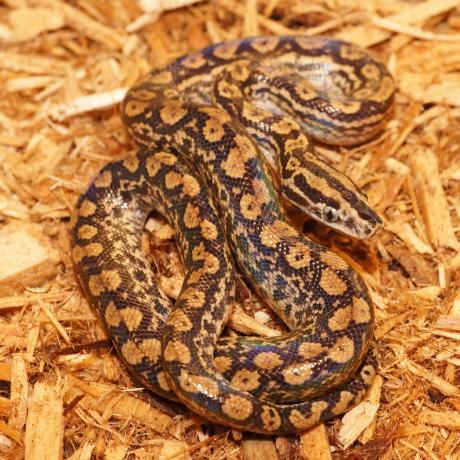

With its iridescent shine, the Paraguayan Rainbow Boa is an attractive snake that reaches 5ft. They retain some of their juvenile patterning over a chocolate brown body.
| Origin | South America (Central) |
|---|---|
| Environment | Subtropics and Forests |
| Adult Size | 5ft |
| Suitability | Intermediate |
| Lifespan | Up to 25 years |
| Temperament | Semi-aggressive |
The Paraguayan Rainbow Boa is a relatively large but slender snake reaching an average adult length of 5ft (1.5-1.6 metres). They have a typical Boa appearance with a flattened head, conical-pointed towards the tip of the snout and has visible thermal pits. As with all other members of the family, the scales contain a thin layer of keratin, this gives them the iridescent shine and colour.
This subspecies of rainbow boa varies enormously in colour and pattern and can be quite difficult to describe, therefore the description could vary for each individual. Neonates (baby snakes) generally look darker compared to adults and have quite distinctive markings, as they start to mature, these tend to fade. The ventral side (underbelly) is light in colour from ivory to off white. The overall base colour varies from light tan to orange-brown with dark speckled flanks (sides), towards the head and neck this looks more like a stripe. The head possesses five distinctive lateral stripes. Circular patterns and what can only be described as a figure of eight, run along the dorsal (back).
Adults tend to show an overall brown colouration, this can be light or dark depending on the form. The circles and rings can blend into the snake’s colour or still stand out like when they were young.
Note: Young snakes can be defensive and will strike out if they feel threatened. Regular handling while young, will help calm them down.
Paraguayan Rainbow Boas are native to subtropics and forest terrains of central and southern Brazil, north Paraguay and eastern Bolivia. They avoid open floodplains and prefer areas with shrub vegetation, this also includes rocky slopes.
We always feel it is best to house hatchling and young snakes in smal plastic tanks, this helps them to feel secure and feed without any problems. As they grow and reach adulthood, provide a vivarium of a minimum length of 3ft, two adults can be housed in a 4x2x2ft enclosure.
You need to aim for a basking/warm area of 30C (86F) and allow the cool area to drop to 21C (70F). If housing in a rub, a heat mat connected to a thermostat should suffice. Vivarium’s will require the use of a ceramic heater protected by a guard and connected to a thermostat. UVB lighting isn’t required, however, providing this will help show off their iridescence shine. If used, you must ensure they cannot pull this down as this will cause injury.
The substrate needs to help keep humidity levels to around 70-80%. The best flooring has to be cypress mulch as this has the benefits of holding moisture and resisting mould and decay. Other good substrates to use would be moss peat, bark chips, and sphagnum moss.
Place a variety of décor items within the enclosure, hides for the snake to feel secure and even sturdy branches, they will climb if given the opportunity. In the wild, they would hide within leaf litter, this will also give a natural feel and look for your enclosure.
Young and growing snakes should be fed appropriate sized mouse/rat every 5-7 days, as they mature, every 10 days should suffice. Check and clean the water every other day, replace if soiled. Lightly mist the enclosure using a hand or pump sprayer once a day to help increase humidity levels.